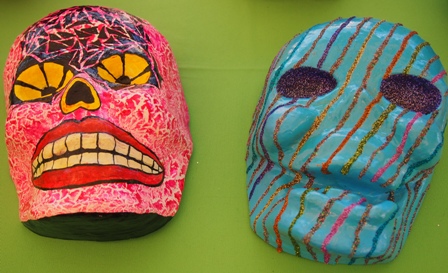The day began sunny and bright… again. No wonder this town is regularly nominated as having the world’s best climate.
Ajijic is where the days and nights meld together in near perfect meteorological unity, a Goldilocks kind of town, not too hot, not too cold; just right.
This morning started at the weekly ’tianguas’ almost round the corner from the hotel. A ’tianguas’ is a market, in this instance an event that serves as a locus for growers and producers from towns strung along the shores of Lake Chapala.
Strawberries, raspberries and blackberries look luscious, dripping sweetness and glowing in the sunshine.
Fish trucked in fresh from nearby Puerto Vallarta array themselves in orderly school queues on ice. A large bonito looks as if it just jumped into the fishmonger’s arms, surprising them both.
Amongst the fruits, vegetables, meats and fish for sale are stalls selling freshly made tacos, tostadas and enchiladas. One of the busiest, a clear favourite, is doing a hot trade with tiny fried shrimp mixed with salsa and shredded cabbage, all rolled into a fresh tortilla. I pay a few pesos and am rewarded with a flavour bomb: sweet prawns fried in their shells, a mildly spicy tomato salsa and cabbage with fresh lime squeezed overall. A tumbler of fresh pressed orange juice while I wait, large and coldly glistening with rivulets of condensed water washes it all down with gusto.
Later I watch a young man roasting coffee beans over a small fire before grinding them the old fashioned way using a hand operated contraption that looks like an heirloom from early last century. I buy a small cup of his Mexican-style cinnamon infused coffee, lean back against a tamarind tree and look up the long leaf canopied street that supports today’s ’tianguas’, and am struck by a riot of colour and light.
Crafts and local arts are also on display. Curios of course, it’s a mixed bag of a market that offers something for everyone. Stopping at a CD stand, listening to a gentle guitar solo, I’m rapt. Something about the doleful sounds of Mexican classical guitar stirs me. If music evokes place, I’m in the right spot at the right time. I listen to that CD (bought it of course) and am instantly transported back to beckoning calls of stall-holders spruiking their wares while six guitar strings pulled at my heart.
Later that day while on a ’Behind the Walls’ tour of a few grand haciendas highly respected for private art collections, emotions are stirred by the generosity shown by the owners who’ve opened their homes to complete strangers to benefit a worthy cause. The tour takes place only a few days of the year to coincide with the country’s largest artisan fair, the ’Feria de Maestros del Arte’ (www.feriamaestros.com). Held in the public gardens in the nearby Chapala Yacht Club (a grandiose term for the town marina), the fair graciously spreads out along the shore of the country’s largest lake, Chapala.
Both the ’Feria’ and the ’Behind the Walls’ tours are non-profit and run by dedicated volunteers.
The ’Behind the Walls’ tours’ monies go to a local school for kids with disabilities. The ’Feria’ profits go directly to all the artists involved, no middle men allowed.
The most recent ’Feria’ drew in over 80 different artists from all over Mexico. Masters in ceramics, textiles, sculpture, painting, weaving and metalwork… all the major arts media are represented.
The fair was begun by an extraordinarily devoted and passionate woman who settled in Ajijic over two decades ago. Marianne Coulson wanted to ensure Mexico’s authentic arts and crafts traditions were not lost to large scale production while mass media focussed on a few big names at the expense of other equally talented artists who happen to live in remote communities.
Many of the artists are from tiny villages in far-flung mountain towns where Spanish is not spoken much less English, and electricity and running water are infrequently available.
Over the years Marianne has gathered round her a loyal following of volunteers. The event has grown so large it’s beyond one person’s capacity to manage. The three day show attracts thousands of visitors from all round Mexico and abroad.
The good people of Ajijic house and feed all the visiting artists, who don’t pay for their involvement but are treated as honoured guests. From these connections, long lasting friendships have been made.
’Behind the Walls’ owners open their beautiful homes to strangers a couple times a year as a fundraiser for kids with disabilities, providing them with a school and specialist teachers.
The houses visited varied from a converted 16th century convent (chapel still intact) to a sleek 21st century showpiece with large windows and clean angular lines. All the homes boast art collections that reflect their owner’s taste and travels around Mexico.
I spent the day like I was with old friends invited over for drinks and a chat.
After a week in Ajijic, I realise this town on Mexico’s largest lake is different to all others I’ve come to know over many years travelling.
The peaceful surrounds and natural beauty attracts a significant number of ex-pats, mostly from the USA and Canada but also from the UK, Europe and surprisingly… Australia. The cost of living is lower here than in their home countries.
At over 1,600 metres altitude, Ajijic is recognised by National Geographic magazine as having one of the three best climates in the world.
Despite Mexico’s ongoing struggle with narco-gang warfare (claiming over 50,000 lives since 2000), Ajijic and the area around Lake Chapala has remained relatively unscathed. Burglaries are rare. Violent crime is almost non-existent.
Unlike ex-pat dominated towns in other parts of the world I’ve visited where cashed up outsiders live behind gilded gates protected by uniformed and armed security guards, Ajijic, Chapala and neighbouring towns have a much more integrated society.
I’ve never witnessed such large scale involvement in local affairs as I’ve seen here. The Mexican federal government is frugal with its education, environment and infrastructure funds so local people have stepped up to offer their help, establishing arts scholarships for students whose parents can’t afford tertiary education, environmental protection groups who safeguard the mountain forests surrounding the lake to preserve the watershed, animal protection groups to protect and sterilise all stray dogs and cats, finding them homes and helping local people to understand the importance of animal welfare. The aforementioned school for kids with disabilities is one of their most impressive projects.
In the centre of Ajijic, The Lake Chapala Society occupies what was once a private hacienda. Frequent art shows fill its gardens, films nights are popular and the whole small complex is open to visitors looking to engage with local people. It’s a nice place just to hang out. You never know who you’ll meet, a famous artist one day, a backpacking vagabond the next. All are welcome but the primary focus of the Society is to serve as a conduit for social benefit and charitable works.
The elaborate colourful painted murals you see on countless Ajijic walls clearly show how seriously this town takes its arts. Without private support, the murals wouldn’t be here. Without them, Ajijic wouldn’t be quite so special. I’ve never seen so much public art in one small place.
The ex-pat community also put its considerable energies into promoting local events such as the ’Feria de Maestros del Arte’. Architectural preservation groups work hard to ensure Ajijic’s extraordinary assortment of centuries old colonial architecture is saved from insensitive development.
All this enthusiasm and respect for the region has resulted in a lively community that embraces the arts, music, good food and lots of social interaction.
Maybe the sense of social responsibility is in the air? Breathe it in long enough and feel compelled to be involved? I can’t explain it otherwise though Ajijic’s history is infused with a very strong sense of community involvement.
Before the Spanish invaders came to this part of Mexico early in the 16th century, Lake Chapala was already a spiritual centre. The lake fed its surrounding inhabitants with fish, waterfowl and insects (the larvae of lake flies were a popular food source, known at ’ahuatli’ in the indigenous Nuahatl language, still spoken in remote areas in Jalisco and other mountainous provinces).
The Nueva Posada hotel has generously posted on its website a concise summary of the Nuahatl history of Lake Chapala: ’Ajijic´s history dates back to a long time before the Spanish conquest. Descendents of the ancient Nahuatl tribe established themselves around the shores of Lake Chapala.
It is said that the first Nahuatl Indian arose from ashes on Mezcala Island. The island is now considered one of the four cardinal points in Nahuatl mythology.
Axixic in the ancient Nahuatl tongue means ¨Place where water is born¨ or ¨Place where water bubbles up.¨ This was mainly due to abundant natural springs of water that existed here many years ago.
Ajijic was renamed and founded by the Spaniards in 1531 and is one of the oldest villages in western Mexico. The conquest of the Chapalteco Sea as it was known back then, was accomplished by Sir Alonso D¡valos, and the conversion of natives to Christianity was the responsibility of father Fray Martn de Jesºs, thus establishing Ajijic as one of the oldest convent towns in western Mexico. The convent was originally established in honour of Saint Francis of Assisi, but at a later date Saint Andrew became our patron Saint and still is to this day.’
It’s a place where the old stone speak, particularly at night when the majority of hard working Ajijic residents sleep.
Wandering the streets at night became an occasional pastime. Being a rural village, most inhabitants are ’early to bed, early to rise’ types. Suffering from a bout of insomnia, a long walk was the best cure for my sleeplessness while enjoying the quiet nights, perusing the town’s murals or gazing over the lake all aglow in moonlight.
When a hoof strikes a cobblestone on a dead quiet night the familiar ’clip-clop’ can’t be anything else.
Seconds later, a horse appeared from behind the corner, its rider barely awake in the saddle. I say a quiet ’Buenos noches’ and hear a grunted reply, ’Noches’, from an old man, face hidden under a wide sombrero, serapi wrapped round his shoulders to ward off the night chill. He didn’t stop to chat.
I’d just left Tom’s Bar a short walk from the hotel, believing it was my sworn duty to check it out. Ten minutes desultory conversation was enough. A boring cricket-fixated dad and son duo touring from the UK who couldn’t explain to me how Mexico fits into the global cricket scene (it doesn’t) interspersed with hiccups and inane comments muttered by a hairy ex-pat Yankee regular who’d seen the bottoms of too many Dos Esquis bottles didn’t impress. The bartender, acting as manager while the absentee owner was in Toronto, was clearly enjoying liberal access to what remained of the bar’s top shelf spirits. The whole scene left me feeling I’d missed the best part of a night at Tom’s Bar. I decided to amble back to the hotel, insomnia nearly cured.
The day had been long and filled with mental and physical activity but still I found it difficult to relax. My head spun with images from that day and the preceding week. Ever since arriving in tiny Ajijic, I’d been caught up in a kaleidoscopic whirlwind of rampantly enlivened imagination and delightful reality.
Taking the long way back to my hotel in Ajijic, I stopped to look at a few familiar murals, thinking they’d look different in the moonlight. The bright colours weren’t nearly vibrant as in strong daylight, but I liked the subtler effect softer light evoked.
The horse popped into my wandering like an apparition from Pancho Villa’s days when this region in central Mexico fought for its freedom against Spanish occupation and economic rule by a greedy oligarchy.
Jalisco is one of Mexico’s most historic states. Ajijic is one of Jalisco’s most important villages. For visitors keen to understand why Mexico is special, there aren’t many other villages better placed to foster that understanding. I chose Ajijic as a base for eight days of cultural immersion with lots of arts, history, great food and more interaction with interesting locals than you could shake a mariachi at.
From Ajijic, day trips to Guadalajara, Tlaquepaque and Tequila are easily accomplished.
Tlaquepaque, essentially an outer Guadalajara suburb, was once a separate village. Typically for Mexico, a large Catholic cathedral dominates the main square, sharing it with the ’Municipalidad’ (Town Hall) whose porticos offer plenty of shade from the sun. Narrow streets are lined with dozens of art galleries filled with curios and antiques. Clothing boutiques, cafes and restaurants vie for attention. Tlaquepaque is a stroller’s ideal, wandering back streets leads to new discoveries, here a discount perfume shop, there another art gallery with prices cheaper than those in the main upscale shopping street, cantinas where locals munch on ’totopos’ (corn chips) dipped in salsa.
Waiting for a trio of chicken, bean or pork tacos doused with hot-as-hell salsa verde while sipping from huge tumblers of ’horchata’ (almond milk drink) or frosty bottles of Coca-Cola, it’s cheap as proverbial chips and a chance to mingle with locals enjoying an inexpensive lunch. (By the way, Mexicans drink more cola per capita than anywhere else in the world. Diabetes is more common here than anywhere else in the world as a consequence.)
Tequila is one of Mexico’s ’Magic Villages’, an official tourism description denoting specially selected towns of historic and cultural significance.
It’s also the home to the beverage that bears its name.
On the high dry plains surrounding the Tequila town, thousands of blue agave plants are cultivated. Blue agave is the key ingredient for the distillation of authentic tequila.
Most of the tequila sold round the world is mixed with sugar cane spirit, more a rum/tequila mix than real tequila. Check the label; it should read ’Tequila 100% puro agave’. If not it’s a ’tequila mixto’ which requires only 51% agave, the remainder comprised of sugar cane spirit, caramel colour, oak extract flavouring, glycerine and other sugar based flavourings.
Aged tequila is like cognac and should be savoured. Lime and salt isn’t part of the tradition.
Visiting one of the oldest distilleries in the region, Don Jose Cuervo, we taste a range of its best tequilas: Tequila Silver, (Plata) or White (Platinum), un-aged tequila in its purest form. Reposado Tequila is aged in oak barrels from two months up to eleven months and has a good balance between wood and blue agave flavours. Anejo (Aged) Tequila is aged in oak barrels of no more than 600 litres size for at least one year and is golden hued. ’Extra Anejo’ (more than two years in barrels) is rare, similar finesse to an aged Cognac and lip-smacking delicious.
’Tequila Gold’ or ’Joven Oro’ is made from Tequila Mixto and is not 100% blue agave.
Don’t waste Anejo tequila in a Margarita cocktail. Tequila Plata is fine in a Margarita but most bars use Tequila Mixto.
Outside Mexico the Margarita is too often bastardised into a nasty drink made with ’Margarita Mix’ (lime flavouring, colouring, sugar syrup and preservatives).
A Margarita is simplicity itself:
(Serves 1)
60 mils Tequila Silver or Plata
30 mils Triple Sec (or Cointreau)
30 mils freshly squeezed lime juice (add sugar syrup if you like your Margarita less sour)
Shake with ice and strain into a salt rimmed cocktail glass or pour into a salt lined tumbler. (To salt a glass rim, use the squeezed lime skin to wet the rim of the glass and invert the glass into a saucer of fine salt. Shake off the excess salt and avoid wetting the glass with water.)
Serve alongside a basket of ’totopos’ and a bowl of tomato/chilli salsa for dipping and you have the beginnings of a Mexican feast. Better still, dip the ’totopos’ into freshly made guacamole and enjoy one of Mexico’s greatest gifts to global gastronomy.
Guacamole:
(Serves 4 as a snack or starter)
3 large ripe avocadoes, flesh scooped from skins into a large bowl with
1 small finely diced peeled onion or large peeled shallot
1 ripe finely diced seeded tomato
1 finely diced chilli (jalapeno is fine) or a teaspoon of Tabasco sauce (or similar)
Handful of chopped fresh coriander leaves
Juice of one small freshly squeezed lime, salt to taste
Note: use more or less chilli if desired; to each his own. Lightly mix together all ingredients, not quite mashing the avocado flesh into a puree, small chunks are fine. Serve immediately.
By the way, did you know that avocados, tomatoes and chillies come from Latin America? (Mexicans never add cream cheese or sour cream to pump up the guacamole. Why ruin a great dish?)
Guadalajara is Mexico’s second largest municipal area, a big city with significant attractions (the Cathedral, the Hospicio Cabanas with its extraordinary Jose Orozco murals, the ornate Templo Expiatorio, the magnificent Teatro Degollado, the colonial Governor’s Palace which also boasts incredible Orozco murals and the city’s huge covered market, one of the largest in Latin America) which can easily explored in a day if you’re happy with a rush of sights.
Guadalajara’s central city is relatively compact. The major sites are within close walking proximity to one another and it’s an excellent place to explore on foot.
Feeling musical? Mariachi music’s origin is Guadalajara. The country’s best mariachi bands are from Guadalajara and good performances are to be found frequently.
Not surprisingly given Mexico’s national tourism body’s fixation on promoting its beach resorts (aimed squarely at the USA, Canadian and European sun-seeking holiday market), central Mexico is mostly left off the mainstream travel routes.
While some smaller beach resort towns haven’t been totally ruined by excessive development, visiting a tourist town like Cozumel or Cabo San Lucas and claiming you’ve seen Mexico is like visiting HongKong and saying you’ve seen China.
Mexico’s history, culture, arts and food are all unique. It’s one of a select few countries on this small planet where differences count for something special.
Ajijic is something of a microcosm of how Mexico is different from its neighbours, indeed from everywhere else.
You’d be hard pressed to find an equally captivating home base.










